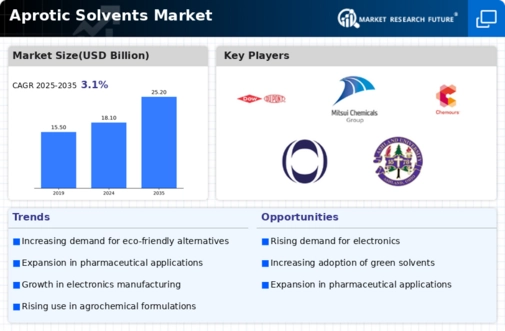Top Industry Leaders in the Aprotic Solvents Market
 The aprotic solvents market is a dynamic and evolving space, driven by a confluence of factors like growing demand from key industries, technological advancements, and environmental regulations. This intricate landscape is characterized by a handful of dominant players locked in a fierce battle for market share, employing diverse strategies to stay ahead of the curve.
The aprotic solvents market is a dynamic and evolving space, driven by a confluence of factors like growing demand from key industries, technological advancements, and environmental regulations. This intricate landscape is characterized by a handful of dominant players locked in a fierce battle for market share, employing diverse strategies to stay ahead of the curve.
Strategies Shaping the Aprotic Solvents Market:
-
Product Innovation: Leading players like BASF, Dow, and Eastman Chemical are heavily invested in R&D, focusing on developing novel aprotic solvents with improved properties like biodegradability, recyclability, and higher flash points. This caters to the growing demand for sustainable and safer alternatives. -
Vertical Integration: Companies like ExxonMobil and CNPC are vertically integrating their operations, ensuring control over the entire supply chain from feedstock sourcing to downstream distribution. This optimizes costs and enhances product quality consistency. -
Strategic Partnerships and Acquisitions: Collaborations and acquisitions are a key strategy, enabling access to new technologies, regional markets, and customer bases. For instance, Lanxess acquired Chemithon's NMP business, significantly strengthening its position in the pharmaceutical solvent market. -
Regional Expansion: Asia-Pacific, with its booming economies and burgeoning industrial activity, is a prime target for expansion. Companies like Mitsubishi Chemical and LG Chem are aggressively investing in production facilities in this region. -
Cost Optimization: Streamlining operations, optimizing logistics, and adopting automation are crucial for maintaining profitability in a competitive market. Companies like Ashland are implementing digitalization initiatives to improve efficiency and reduce production costs.
Factors Influencing Market Share:
-
Product Portfolio: Offering a diverse range of aprotic solvents catering to various applications like oil & gas, pharmaceuticals, and paints & coatings is crucial. A comprehensive portfolio like BASF's Solvents & Intermediates division gives them an edge. -
Brand Reputation: Established brands like Dow and Eastman Chemical enjoy a strong reputation for quality and reliability, attracting loyal customers and facilitating premium pricing. -
Distribution Network: A robust and efficient distribution network ensures timely delivery and market reach. Companies like Solvay are investing in expanding their distribution channels to reach new customers. -
Sustainability Initiatives: Demonstrating commitment to environmental sustainability through green solvent offerings and responsible production practices is becoming increasingly important. Companies like Evonik are actively developing bio-based aprotic solvents to cater to this growing demand.
Key Companies in the Aprotic Solvents market include.
- BASF
- DowDuPont
- Eastman Chemical Company
- INEOS
- Mitsui Chemicals
- Shell International
- Asahi Kasei
- Ashland
- AlzChem
- Celanese
- Imperial Chemicals Corporation
- Nanjing Jinlong Chemical
Recent Developments:
-
October 2023: Eastman Chemical announced the expansion of its NMP production capacity in China, aiming to capitalize on the growing demand from the pharmaceutical industry. -
November 2023: BASF launched its new GenC3 aprotic solvent, a bio-based alternative with superior performance and sustainability credentials. -
December 2023: Dow Chemical signed a strategic partnership with Lanxess to develop and commercialize next-generation aprotic solvents for the electronics industry. -
January 2024: The European Commission proposed a ban on certain hazardous aprotic solvents, further propelling the demand for safer alternatives. -
February 2024: Exxmobil announced plans to invest $1 billion in a new aprotic solvent production facility in Singapore, targeting the growing Asian market.

